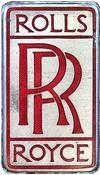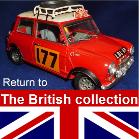
1959 Rolls-Royce Silver Cloud series II
Silver Cloud
The Silver Cloud was the core model of the Rolls-Royce range selling from April 1955 to March 1966. It ran in conjunction with the Bentley S-Type as part of a range rationalisation, and was much the same car apart from the radiator grille styles.
Design and development ran over a four year period sparked off by the companies 1950 decision to find a new look for their automobiles. The Silver Dawn was much derived from the pre-war designs and not only looked dated but was being outmoded in it's mechanicals and production methods. Engineers looked at every aspect of the Silver Dawn and J. P. Blatchley's new creation was larger and heavier than the Silver Dawn but looked and behaved every bit as well as the discerning Rolls-Royce customers of the late 1950s and early 1960s had come to expect.
The longer chassis was now a welded box-frame section instead of the open channel chassis of the earlier Silver Dawn and Bentley R Type. Being stiffer it gave the car better handling and ride characteristics, something also enhanced by independent front suspension (although the rear suspension remained by semi-elliptical leaf springing), and, from 1956, the addition of the Marles/Rolls-Royce power-assisted steering system. In an improvement to the servicing times the chassis had a one-shot lubrication system apart from the front suspension, which had nipples fitted for hand-gun lubrication, and the rear leaf springs which where now packed with “moly-lubricant”.
The engine from the Silver Dawn had been bored out to the maximum but an entirely new aluminium cylinder head was designed for the straight six motor which now had six separate inlet and exhaust ports instead of the previous system of sharing four ports between the six cylinders. Full-length cylinder liners were fitted and the new head helped increase engine capacity 4887cc. This, and the twin horizontal S.U. Carburettors, increased the power output to around 157bhp. The first Silver Clouds were only available with a four-speed automatic gearbox which transmitted power to the very reliable, hypoid-bevel rear axle and final drive assembly which was given a new ratio of 3.417:1. This unit was very similar to that of the Silver Dawn but with so many detail modifications that none of the parts from the either unit were interchangeable. The Silver Cloud was available in either left-hand or right-hand drive for the home and foreign markets. As the car was heavier braking was up-rated too. Disc brakes were still in the development stage so the Girling drum brake system was optimised by increasing the lining area in the drums. Hydraulic application was used all round but acted on a mechanical linkage at the rear to retain the classical Rolls-Royce feel to the brakes, it also meant that the braking system was fail-safe. The hydraulics were boosted by a mechanical servo which in turn was boosted by the decision to increase the speed at which the transmission-driven shaft span. In another 1956 improvement twin master cylinders were used, one each for the front and rear brakes. Wheel/Tire size was changed 15 inches by 8.20 inches.
Following on from the Silver Dawn initiative the Silver Cloud bodies were made in house (largely from Mulliner components), although this operation could be put out to other coach-builders including, H. J. Mulliner, James Young and Park Ward Ltd. for any customer who wanted custom coachwork, specifically drophead coupes or convertibles which the factory did not produce. The cabin itself was much roomier, and lower, as well as moved forward to improve the ride for rear seat passengers. The system of air circulation was modified to improve booth cooling and heating and from October 1956 the option of air conditioning, or “Refrigeration” as was known at the time, became available. Although this had existed in the U.S. since 1940 it was a novelty in the UK and its cost of an £577, including tax, was almost as much as the price of a new Morris Minor.
In late 1957 Rolls-Royce introduced a long wheelbase version of the Silver Cloud which was set at 127in (3226mm) to fall between the standard Silver Cloud and the enormously long Phantom V's wheelbase of 145 in (3683mm). Outwardly there is little to distinguish the long wheelbase cars from the standard version but the clue lies in the addition of a rear quarter light built in to the bodywork behind the line of the rear doors, this window is part of the door itself on the standard model. As the long wheelbase model was somewhat heavier the engine had another upgrade resulting a final power output of 178bhp. This was the end of the line for the 6 cylinder B60 engine which had served Rolls-Royce so well, but with the 1960s approaching a new power unit was going to be needed for the marque to progress any further.
The Silver Cloud II
The new engine was key and in late 1959 Rolls-Royce departed from the straight six engine, considered a straight eight, design but ultimately adopted a V-8 power plant building on the companies vast experience in aircraft engines. This V-8 displaced 6230cc, nearly 1.5Ltrs more than the B60 and put out 30% more power. The cylinder blocks were Aluminium with wet liners, larger S.U. carburettors were fitted so a well-tuned engine could propel the new 2.11 tonne model from 0-60mph in 10sec's and top speed was raised to 114mph (183km/h). Fuel consumption was 13mpg (22L/100km; 11mpg-US). The improved torque and acceleration gave the Silver Cloud II a significant advantage over the original model and sales figures from the three years of the series 2 version clearly outstripped the four year production run of the original Silver Cloud. However critics do mention that the V8 was not as quiet as the straight six despite the new engine's hydraulic tappet operation, and problems with bearing lubrication led to several crankshaft breakages early on in the ranges production.
In order to facilitate the new engines fitting the steering box had to be moved from inside to outside of the chassis frame. Power-assisted steering was now standard and provision was retained for air conditioning too. The option for electrically operated windows became available although the transmission remained the same Rolls-Royce four-speed automatic gearbox.
Other mechanical refinements included the change from pressed front suspension wishbones to forgings and a stiffer anti-roll bar as well as further speeding up the operation of the brake servo, to overcome delays in the power take up at low speeds, and adjusting the front/rear braking.
Another move saw the one-shot chassis lubrication dropped in a return to oiling or greasing points with individual reservoirs which were topped up at 10,000 miles or yearly intervals.
In the cabin the steering wheel was reduced in size and moved closer to the dash, which from 1961 had blue instrumentation lighting introduced, the addition of handbrake warning light and a combined indicator/ high beam flasher switch. Burr walnut cappings accented the opulent interior panels and a new air recirculation system was introduced. This air system could provide warm, fresh or refrigerated air, or even mixtures thereof. The grille for the air-conditioning was in the floor behind the right hand front seat but the emphasis for the point of circulation and warth changed from the rear to the front seats reflecting the social changes of the time and fact that the owner themselves was more likely to be the driver now instead of a chauffeur. In the fully carpet boot there was jack and large tool kit, and the car was also supplied with a small tool kit which even included Lucas bulbs.
Externally from May 1962 single sealed-beam headlamps were employed and the rear light assembly was introduced from August 1962. The long-wheelbase chassis version was kept usually with the Park Ward conversion of the standard sedan although there was also some very nice coachwork by James Young and the venerable firm of Hooper before they closed their doors in 1960.
Silver Cloud III
The series 3 version was available between 1962 and 1965. It features a revised front end which was lowered to reduce frontal area and now had four headlamps rather than two but was in other ways much the same as the series 2 car.
Approximately 8,200 Silvers Clouds, of all models and styles, were built before it was replaced by the Silver Shadow. This beautiful car was very popular with famous singers Elvis Presley and Frank Sinatra and British rock band Jethro Tull mentioned the Silver Cloud in one of their songs "Up To Me," which has the "I'll buy a Silver Cloud to ride.





1/24th scale kit.
Built by Rod.


The 1/24th scale Entex kit, # 9111 was apparently released in the 1980s. The kit has a look and feel that suggest an earlier product possibly by another company. Hubley released several kits in 1/24th scale and kit # 175K-200, a Rolls-Royce Silver Cloud appears identical in almost all aspects.
The same Entex kit was released in 2013 by Minicraft titled the “Phantom Squire” with a woody look kit# 11225. The woody effect is achieved through decals and the actual kit is the same as the original Entex release. Interestingly Minicraft also released some boxes that erroneously stated the kit was 1/16th scale making these more collectible and expensive to buy on the second hand market.
Our model was originally made in the 1980s using Humbrol enamel paints applied by brush. If ever a model car deserved a make over it would be a Rolls-Royce and Rod restored this model in 1997. It is now finished with Halfords acrylic car spray paints making it look much more upmarket than the Humbrol enamels did. The interior is still painted with Humbrol enamels, with additional accents by Citadel acrylic paints and ink washes.
Information in restoring model cars can be found in our "Articles and Projects" pages.
RETURN TO :-
